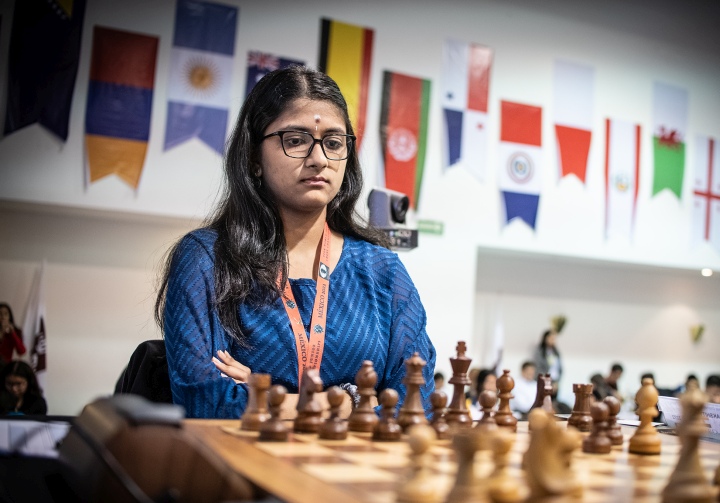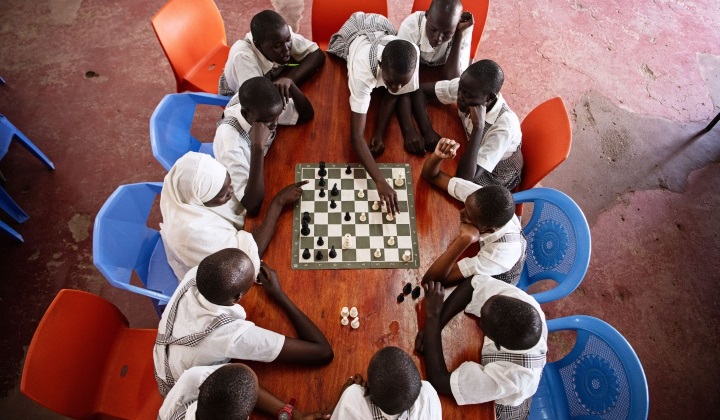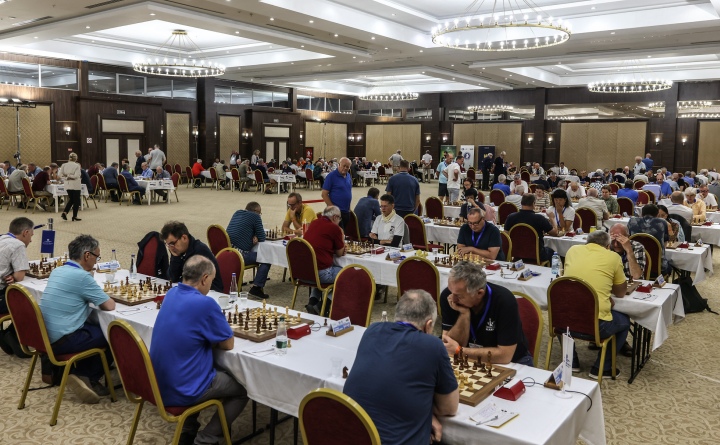Maurizzi, Rakshitta and Yip lead FIDE World Junior Championship

The main excitement in the 5th round of the FIDE World Junior Championships came from the Girls’ tournament, where WGM Carissa Yip made quite a statement beating IM Mariam Mkrtchyan. The Armenian had won all her 11 games at the World Championship U18 last year, and the first four games here in Mexico, but her fantastic run came to an end today. The aggressive and tactical style of the players immersed us in a chaotic game where both strived for the win. The American came up with an interesting novelty, 8.f3. A key moment in the game was the advance 16.f4?! by Carissa, which gave Mkrtchyan a clear advantage, not with just one, but several different answers. However, the position remained very double-edged, and both players made their share of inaccuracies. The Armenian missed several tactical blows that would have been decisive, and somehow allowed her opponent to survive and advance not just one but two of her pawns to the 7th rank, allowing Yip to get away with one of the biggest swindles in the competition so far. The other decisive result on the top boards came in the game between Alessia-Mihaela Ciolacu and Ravi Rakshitta. Just when the Romanian had achieved a clear edge, around move 29, she made a couple of mistakes that allowed Rakshitta to get the pair of bishops and open the position in her favour. The fatal mistake was 53.Nxc5?, a move that tied the White King to the defence of the Knight. A fine swindle too by Rakshitta, who comes from chess-playing parents with international titles and several medals at national and regional championships. She will have the White pieces against Carissa Yip in the sixth round against her co-leader, in a game that could be decisive for the final victory. In the open category, French Grandmaster Marc’andria Maurizzi continues to lead. He drew, with the White pieces, against Arseny Nesterov, in a very correct but not-so-exciting game. ”It was a solid game where there were no combat opportunities”, summed up Nesterov in the post-game interview. This result was good enough for Maurizzi to continue leading, as all the games in the top seven boards ended with the same result. He is followed by no less than 16 players with 4 points; among them, the Americans Hans Niemann and Andy Woodware, who won their round 5 games, as well as Latin American Santiago Avila Pavas. Monday 25 will be a rest day, and most of the players will take an excursion to the Pre-Hispanic City of Teotihuacan, some 50km northeast of Mexico City, to visit the pyramids. Built between the 1st and 7th centuries A.D., this archaeological site is characterized by the vast size of its monuments – in particular, the Temple of Quetzalcoatl and the Pyramids of the Sun and the Moon. Play will be resumed on Tuesday, at 16:00 local time (-7 GMT) Standings after Round 5: OPEN GIRLS Written by David Llada Photos: David Llada
Chess for Protection: Two years and counting

The game of chess greatly benefits society, as it offers people the opportunity to reach their full potential, regardless of their background, by gaining self-confidence, experiencing social integration and learning valuable life skills. It is the primary aim of the Chess for Protection project, implemented in collaboration with the International Chess Federation, UNHCR, the UN Refugee Agency, the Lutheran World Federation (LWF), the Kenya Chess Federation and the Kakuma Chess Club. The program, launched in August 2021, consolidates and develops chess-related activities in Kakuma Refugee Camp in Kenya. It is now entering its third year of running. A chance to heal, develop and grow “In FIDE, we really believe that chess is more than a game; it is a tool to improve the so-cial environment for millions of people. Kenya has the second biggest refugee camp and the third biggest slum in the world. Over 55% of the refugee population here are children and adolescents. Chess as a part of the extra-curricular activities will undoubtedly contribute to the well-being of youth, their psychological needs and their development. FIDE thanks UNHCR, LWC and Chess Kenya for their support in carrying out this very important social project,” says FIDE President Arkady Dvorkovich. Forced to flee their homes, the refugees are exposed to extreme stress that may impact their psychosocial well-being. Most of them are not engaged in any income-generating activities, which leaves them vulnerable to risks of being involved in dangerous behaviour – crime, violence, drugs, and gang activities – as a means for coping with the situation. That is why it is critical to ensure youth are engaged in meaningful activities where they have a chance to heal, develop and grow. And chess can help with this. “This is not just about chess; it’s about giving dreams to children and youth. This is particularly important when it comes to the lives of people in vulnerable situations. There’s strong evidence that chess increases analytical skills, self-esteem and the understanding between the cause and the consequence. Besides, it teaches not only how to win but also how to cope with defeat. Pupils attending chess classes are not only experiencing self-improvement and self-growth, they also bring enthusiasm and inspiration to their communities, acting as agents of positive changes there,” says Dana Reizniece-Ozola, Deputy Chair of the FIDE Management Board. Over the last two years, more than 2,000 refugees were introduced to chess, 36 chess clubs were established in Kakuma refugee camp and Kaloboyei settlement, over 350 chessboards were bought for these clubs, 21 facilitators were trained and are now teach-ing chess in the region, as part of the Chess for Protection project. Besides, FIDE provided fourteen bicycles and one motorbike for the mobility of those trainers. It did not take long to see the results of such efforts. “I’ve supported the project since August 2021, and it’s been such a rewarding experience for me. The chess program is having such a positive impact on the lives of the students – they are concentrated and focused at school, and they are competent problem solvers – all of them are becoming better students because of their participation in the chess group,” says Ina Guya, Protection Associate in Kakuma refugee camp. “Through the series of games and tournaments, the players have learned to manage their emotions, handle wins and losses gracefully, and cope with frustration when things don’t go as planned.” Women’s empowerment through chess In parallel with training the youth and kids in Kenyan schools, FIDE focuses on empowering young females and girls. Many of them find it difficult to meaningfully engage in education and extra-curricular activities due to negative cultural norms that often prevent them from equal access to opportunities. Chess for Protection project includes activities of the Girls Club, where, apart from playing chess, club members are meeting and communicating with successful women, reading and discussing books, attending painting workshops and many other classes. Spearheaded by Anastasia Sorokina, Chair of the FIDE WOM Commission, the project was first launched in 2021 in Angelina Jolie Primary School in Kakuma with an attendance of 40 students. After two years of running, it now includes three girls’ boarding schools in the region – Angelina Jolie Primary School, Morneau Shepell Secondary School and Bhar-El-Naam Primary School – with 250 refugee schoolgirls having chess classes twice a week. “When we embarked on this adventure, our goals were clear: to introduce chess to young girls and foster their creative development. And we are on the way to achieving that and so much more,” says Anastasia Sorokina. Female students attend online lessons by WGM Anastasiya Karlovich (UKR) and IM Salome Melia (GEO). They also study and play chess with a local tutor. “We started with groups of girls who may not have known what chess was, but they embraced the opportunity to learn with open hearts and minds. Week by week, they learnt little by little, from how to move pieces and set up the board to the more complex strategies. Their determination to improve their personal chess skills was truly inspiring,” says IM Salome Melia, chess trainer of the Girl Club Project. “We have had the pleasure of getting to know these girls and seeing their progress and growth of self-esteem and confidence. Their determination and positive attitude demonstrate that chess is not just a game; it’s a powerful instrument of transformation, a gate-way to a world of endless possibilities. The progress these girls have made fills us with happiness, and we can’t wait to see them in Kakuma in person one day,” adds another chess trainer, WGM Anastasiya Karlovich. For some of these girls, chess is just a tool to improve their school performance, problem-solving, and analytical skills; others wish to become professional chess players. “I have learned how to play chess in my school club, and I really like the game. It helps me a lot in my everyday life, improving my thinking and behaviour. It is not so easy to learn the game, but I see the progress all the time. I like to play with
FIDE World Senior Team Championship: Day 6 recap

USA grabs the lead in S50; Germany Lasker Schachstiftung GK tops the standings with a perfect score in the S65 section. In Round 6, the number of draws remained the same, but what increased was the number of blunders. In the duel of the leaders, USA and Iceland, both on 9 points, the Americans made solid draws with Black on boards two and four, Kaidanov (2549) drawing Petursson (2396) and Yermolinsky (2419) drawing Thorallsson (2382), but this didn’t mean that their players with the white pieces had everything under control. True to his creative style, Shabalov (2465) found ways to unbalance even the slow and strategic Chigorin Variation of the Ruy Lopez. However, Hjartarson (2432) was up to the task, and the complexity of the position made the evaluation swing drastically. Both players missed chances, but none too obvious. Here’s the last moment in the game when Black could have won. The mess is obvious. White’s last move. 41.Ne3xf5 was a mistake. Better was to play 41.Rcg1, but even there, the position continues to be extremely complicated. In the position on the diagram, Black should have taken on f4 (instead of g6 as in the game) and after 41…Bxf4! 42.Rg4 Bxc1 43.Ne7 Kg7 44.gxh7 Kf7 45.Ng8 Bb2! manages to stop the h-pawn from promotion. In spite of being a full rook down, White can continue to create problems with 46.Bg6 Kg7 47.Be4 Kh8 48.Ne7, etc., but objectively Black should win. By taking on g6 Black allowed a pretty and very unusual construction that forced a perpetual check. White’s last move was 44.Bf5 and after Black took the rook, White gave perpetual with Nc8-d6. A unique harmony of the white pieces! The decisive win was scored by Ehlvest (2530) on board three against Arnason (2419) in another Ruy Lopez. White obtained an advantage after the opening in which Black missed an important zwischenzug and from then on, it was a game with only two results possible: a win for White or a draw. Ehlvest was not always very precise, letting his advantage slip away, but that was never obvious, and Black failed to make the most of his chances. The critical moment was just before the time control. White has just played 39.Bc3, threatening Qf6. Black’s only move was 39…Ne5, but he vacillated for one move too long with 39…Qd7? after which 40.Qe4 (40.Qh3 was even stronger) followed by Qd4 led to White soon winning a pawn. The rest of the game was exemplary, with the final zugzwang illustrating the domination of the bishop over the knight. Black chose 67…Nb1 and lost the knight after 68.Be3 and Kb2, but going to b5 wasn’t much better, as after 68.f4 Kb7 69.Kc4 Ka6 70.Kb4 Black ends up in a lost pawn endgame as the knight has no moves. An extremely important win for the USA, now leading the event as sole leaders. The match between Italy and Austria was riddled with blunders. The first game to finish was on board four, where Denk (1581) didn’t really have to lose in mere 7 (!) moves to Borgo (2333). White didn’t play the opening too well, but there was no need to play 7.Bb5?? After 7…Qa5+ Black won the b5-bishop. Denk resigned. Soon after, Opl (2151) blundered against Bellia (2388). Instead of the normal 19…Kh7, defending the pawn on h6, Black went for a “combination”. He played 19…Qf6? and after 20.Bxh6 Bxh6? (sticking to his plan) 21.Qxh6 delivered his shot 21…Bxh3, missing however 22.Ng5, both threatening with checkmate on h7 and attacking the bishop on h3. Naturally, Black resigned. On board two Ortega (2410) perhaps thought that the Austrians had been too kind. Against Druckenthaner (2182) he had the advantage, but misplayed it and reached the following position. After 35…Rxa5 36.Rh8 Kg7 37.Rxe8 Nxd5 Black should draw, but instead, he chose the suicidal 35…Ra8?? 36.Rh8 Kg7 37.Rxa8, which left him a full rook down. The stabilising presence on board one was Godena (2429), who managed to draw from a winning position a full exchange up against Denk (2186). It should have been a convincing win, but even a minimal one would do for the Italians, who are now second, only a point behind USA. The match between North Macedonia Alkaloid and England 1 was no less dramatic. On board one Adams (2662) seemed to surprise Georgiev (2542) in the opening and quickly took the initiative with the black pieces. The initiative was transformed into an extra pawn that Michael carefully nurtured to a win in 60 moves, without allowing his opponent a single chance. There were two relatively calm draws on boards two and four, where neither Emms (2448) could pose serious problems to Bogdanovski (2385) nor Davies (2354) could create much against Kutirov (2274). All the drama unfolded on board three in the game between Stanojoski (2351) and Arkell (2352). Playing his favourite Caro-Kann, which was met by Stanojoski’s favourite Exchange Variation, Arkell was fine after the opening, but allowed White to expand too much on the queenside. Then it was White’s turn to mess things, and he did so badly. The knight jump to e5 was bad as after the exchange there Black now played 25…Rc3! The queen had to go to f4 since 26.Qd2? Rg3 loses. After 26.Qf4 f6! 27.Bb8 Rcc8 suddenly the bishop was trapped on b8 and Black was a clear piece up! Stanojoski continued as if nothing had happened and Arkell started to play passively, moving his pieces to the last rank. He was still winning, but it was obvious that he wasn’t getting closer to victory. Then, just before the time control, he blundered all of his advantage. Instead of 38…Qf8 or 38…f5, he played 38…Be4? (which was good some moves earlier) and after 39.Bxe4 dxe4 40.a5 all of a sudden, White was not lost anymore! The activity of White’s pieces, the passed a-pawn and the passivity of the black pieces balance each other out. Arkell continued to play with a great degree of hesitation and soon enough blundered again. Here, probably the simplest was 44…Rf8, avoiding any tricks based on Rxf6, but moves like 44…Kg7 or 44…Rc1 were fine too. Instead, after 44…Rc7? 45.Rb6! with the threat of Rb7 White was winning! Probably in a state of

